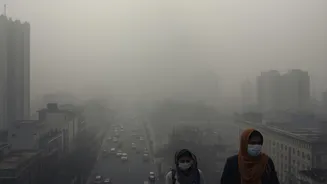AQI and Mood
When the AQI climbs past dangerous levels, such as the 400 mark, the consequences for mental health become increasingly evident. A 2021 study conducted
in Beijing, China, discovered that college students experienced a mood index decrease of approximately 30% under these conditions. Concentration becomes a struggle, and simple tasks become more difficult to manage due to impaired cognitive function. Furthermore, a 2023 report jointly released by the World Health Organization and the Yale School of Public Health revealed that as the AQI ranges between 300 and 500, there's a 15-20% uptick in cases of anxiety and depression. Social media data also paints a concerning picture, with increased reports of fatigue, anger, and sadness. Irritability and confusion, specifically, were found to disproportionately affect children and the elderly, signaling a widespread impact on diverse demographics.
Brain Function Impacted
High AQI levels do more than just affect mood; they can directly harm your brain. A 2020 study from Harvard indicated that in cities where the AQI stays above 300 for over 60 days a year, there's a decrease in brain capacity, and life expectancy is reduced by as much as five years. When the AQI is above 400 for extended periods, the brain is reported to feel foggy and less efficient. This occurs because pollutants, such as PM2.5, NO₂, and O₃, enter the bloodstream and trigger brain inflammation, resulting in cell damage and affecting cognitive and emotional functions. The presence of these pollutants has been linked to disruptions in critical brain chemicals like serotonin and dopamine. These chemical imbalances can lead to increased risks of depression, anxiety, and mood swings. Elevated levels of stress hormones, such as cortisol, further complicate matters, contributing to sleep disturbances and emotional instability.
Inflammation and Risks
The inflammation caused by polluted air has significant implications for long-term health. PM2.5 particles are particularly dangerous because they activate inflammatory cytokines in the brain. This activity increases the likelihood of developing neurodegenerative diseases such as Alzheimer’s and Parkinson’s disease. In addition to the direct effects on the brain, polluted air also reduces oxygen levels in the body. This can lead to blocked nasal passages and disrupted sleep patterns, which, in turn, can exacerbate mood disturbances. Furthermore, pollutants can interfere with the production of crucial neurotransmitters, decreasing serotonin and dopamine levels. This leads to increased feelings of sadness, irritation, fatigue, and a reduced interest in everyday activities.
Delhi's Pollution Crisis
Following Diwali, Delhi's AQI often surges past 400, highlighting the severity of the pollution problem in the city. The primary culprits include PM2.5, NO₂, and O₃, which infiltrate the bloodstream and trigger a cascade of adverse health effects. These pollutants enter the brain, leading to inflammation and cell damage, which subsequently disrupts mood and cognitive abilities. Specifically, the disruption of serotonin and dopamine levels is a common outcome, raising the risks of depression, anxiety, and a decline in cognitive functions. The dominance of sadness and irritability are frequently observed symptoms among those exposed to high AQI levels, underscoring the immediate and pervasive impact of Delhi's air pollution on its residents' mental well-being.
Breathing in Toxins
When the AQI crosses 400, the concentration of PM2.5 and PM10 particles skyrockets. These minute particles can bypass the lung's defenses, entering the bloodstream. Alongside them, gases like nitrogen dioxide, sulfur dioxide, ozone, and carbon monoxide also seep in. Due to their small size, these particles and gases can penetrate the blood-brain barrier, directly influencing the neurons within the brain. This direct access to the brain can cause a gradual deterioration of brain function. The health implications stemming from breathing in such polluted air are extensive. It is essential to be aware of the immediate and long-term consequences of exposure to poor air quality, and to adopt preventive measures to mitigate its harmful effects.

















